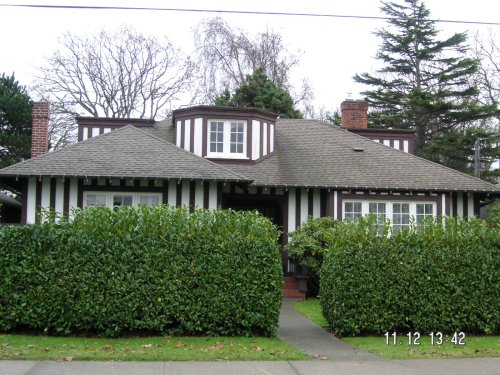2493 Currie Road


This hipped roof, one and one-half storey with crawl space half timbered cottage with a front Scottish dormer is part of the heritage cluster of single-family residences facing Windsor Park. Screened by a laurel hedge and surrounded by many mature trees and shrubs on a lot that retains the original, custom built garage, 2493 Currie Street has a long street frontage and helps to define the park edge. The residence is located across the park from its larger counterpart (Maclure, 1912) at 2450 Windsor Road.
Built in 1927, this residence was designed by local architect and native British Columbian, Samuel Maclure (1860-1929), and is a late example of a British Arts and Crafts residence; an architectural style favoured by the wealthy between 1910 and 1925. Maclure developed this style into a distinct regional identity, with a pronounced horizontality and use of local materials. One of the features of this house is its highly decorative British Arts and Crafts front entrance, inset with particularly fine full-length side lights and glazing on the front door, all of which are leaded and stained. Another prominent feature of the home is the variation of the Scottish dormer above the front entrance, an architectural element rarely employed on the West Coast.
Indicative of the desirability and prestige of the area, Margaret Marsh commissioned Maclure to design this home for her; new and smaller version of the half timbered dwelling directly across Windsor Park that she had shared with her estranged husband at 2450 Windsor Road. This cottage makes a significant contribution to the ambience of the Windsor Park neighbourhood. The irregularly shaped park, built in 1896 by the BC Electric Railway Company, was considered the finest athletic grounds on the Pacific Coast, featuring professional baseball, a cycling track and grandstands for 2,000 people. It continues to be a popular venue for cricket, tennis and rugby and the starting point for one of the most important events in the local calendar – the Oak Bay Tea Party Parade. The English ambience of the area is further promoted by the Oak Bay Rose Garden, created in 1937. The single family homes situated on Currie, Windsor and Transit Roads, which form three sides of the park, are a similar scale and height which define the park edge and create a sense of continuity.
Samuel Maclure is closely identified with the predominantly British Arts and Crafts style of the domestic architecture he designed for prominent English businessmen on Vancouver Island and the Lower Mainland. His reputation for designing exceptionally beautiful homes led to his largest commission, as the architect for Hatley Castle, on the outskirts of Victoria, for James Dunsmuir, Premier (1900-02) and Lieutenant Governor (1906-1909) of British Columbia. Now part of Royal Roads University, Hatley Castle was, when it was built, considered perhaps the finest home in Canada. He gained international recognition during his forty-year career, with close to five hundred commissions. Maclure utilized many stylistic influences and was able to adapt his use of indigenous materials with versatility. Many of Maclure’s buildings with their beautiful and functional interiors have been recognized as masterworks and are considered part of the cultural heritage of British Columbia.
- view to Windsor Park adjacent to other heritage homes;
- location across the park from 2459 Windsor Road, a larger version of this residence;
- form, scale and massing;
- hipped roof;
- concrete foundation and wood frame construction;
- style details such as exposed rafter ends, vertical half timbering;
- exterior architectural elements: inset front door, two corbelled brick chimneys (one interior; one exterior), Scottish dormer above the front entrance;
- leaded side lights and glazed wooden front door, multi-pane leaded casement windows; some in multiple assembly, windows with central pivot, rectangular bay window;
- interior features: woodwork including pocket doors, window seat, wide floorboards, picture rails, exposed ceiling beams, fir floors, coal burning fireplace with original tile and cast iron screen, fireplace between kitchen and living room with exposed brick on kitchen side, original radiators, light fixtures;
- landscape features: original garage with exposed rafter tails and multi-paned glazing, and stonework on the property
 Instagram
Instagram
 Facebook
Facebook
 Twitter
Follow @DistrictOakBay
Twitter
Follow @DistrictOakBay